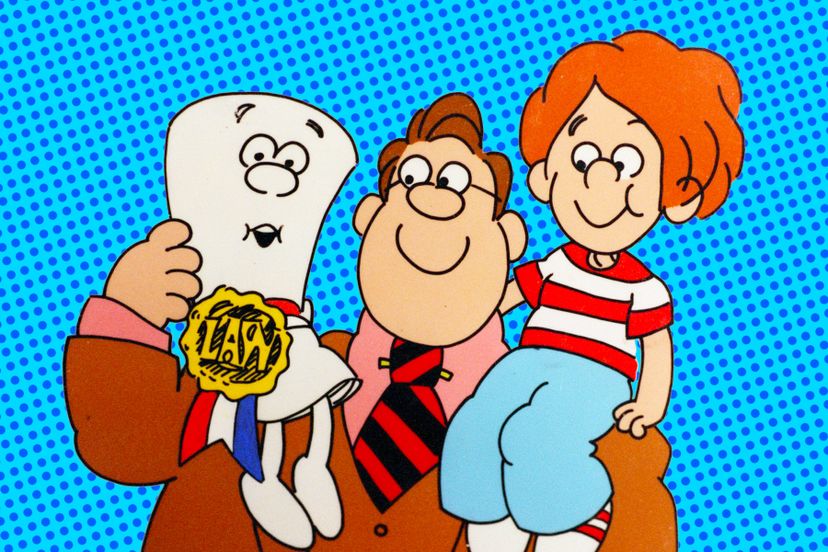
About This Quiz
From the 1960s to the 1990s, Saturday morning cartoons ruled television screens. From "The Smurfs" to "Scooby Doo," how well do you recall this golden age of animation?"The Flintstones" featured a modern Stone Age couple, Fred and Wilma Flintstone, and their friends, Betty and Barney Rubble.
When "Tom and Jerry" first aired on Saturday mornings, Tom and Jerry were enemies. By 1975, however, the cat and mouse were drawn as friends in an effort to tone down cartoon violence.
Bugs Bunny, the star of the long-running Warner Bros. cartoon of the same name, was a Saturday morning cartoon darling for nearly four decades.
Advertisement
Elmer Fudd, a perpetual hunter scouting for rabbits -- Bugs Bunny, in particular -- once said, "It's wabbit season, and I'm hunting wabbits, so be vewy, vewy quiet!"
The majority of "The Smurfs" characters lived in mushroom-shaped houses deep in the forest. The show's villain lived in a castle.
Yogi Bear, animated star of "The Yogi Bear Show," entertained Saturday morning viewers in the 1960s with his antics in Jellystone Park.
Advertisement
"The Huckleberry Hound Show" aired from 1958 to 1962 and featured Huckleberry Hound, a smooth-talking Southern dog who was a jack-of-all-trades.
"DuckTales" was the animated series that featured Scrooge McDuck and his three grandnephews, Huey, Dewey and Louie. It aired on ABC until 1999.
Captain Caveman, the star of "Captain Caveman and the Teen Angels," aired from 1977 to 1980. He shouted "Captain Caaaaaavemaaaaan" whenever he came to the rescue.
Advertisement
"The Jetsons" animated series aired on Sunday evenings for one season that spanned 1962 and 1963. Re-runs of this space-age family were televised on Saturday mornings until the late 1980s.
The villainous wizard Gargamel wanted to capture the Smurfs because they were a crucial ingredient in a potion that would turn ordinary objects into gold.
In the 1958 episode, "Weasel While You Work," Foghorn Leghorn wards off a weasel with his quick wit and, in the process, says, "The snow, I say, the snow's so deep, the farmers have to jack up the cows so they can milk 'em. But I like winter!"
Advertisement
"Josie and The Pussycats" was an early 1970s Saturday morning cartoon series that featured popular music played by a group of female musicians.
"The Bugs Bunny Show," which aired on CBS from 1968 to 2000, moved from prime time to Saturday morning after its first two seasons. It became a Saturday morning cartoon staple, drawing viewers for nearly 40 years.
In 2008, when viewers tuned in to Fox on Saturday mornings, they didn't see cartoons. Fox devoted Saturday morning air time to infomercials instead.
Advertisement
"The New Adventures of Mighty Mouse" was a short-lived Saturday morning cartoon that aired from 1987 to 1988. Its hero was Mighty Mouse, a big-eared mouse who wore a signature red cape.
When Saturday morning cartoon viewership was at its peak during the 1970s and 1980s, it regularly drew more than 20 million people . By 2003, top-performing shows were attracting about 2 million viewers.
On Sept. 27, 2014, the CW was the last television network to broadcast a block of Saturday morning cartoons, replacing the animated lineup with non-animated, teen-focused shows.
Advertisement
"I Hanker for a Hunk of Cheese" was an animated public service announcement that aired during Saturday morning cartoons in the early 1970s. Many adults can still recite the lines uttered by an anthropomorphic piece of cheese: "When my get-up-and-go has got up and went, I hanker for a hunk o' cheese."
In 1992, NBC swapped Saturday morning cartoons for a weekend edition of the "Today" show and a smattering of teen comedies, including "Saved by the Bell." It was the first broadcast network to do so.
"Schoolhouse Rock" debuted on Jan. 6, 1973, with four three-minute shorts, including "My Hero, Zero." The series went on to include "Lolly, Lolly, Lolly, Get Your Adverbs Here."
Advertisement
"Sealab 2020" aired for only a single season in 1972. It featured the animated adventures of oceanauts working at Sealab, an underwater research station, in the year 2020.
Polonaise in A-flat Major Op. 53 by Frederic Chopin, can be heard in the 1947 Woody Woodpecker cartoon "Musical Miniatures." In the episode, Woody Woodpecker and Andy Panda perform a number of Chopin's compositions for barnyard animals.
Fat Albert, the main character of an animated series of the same name, was known for saying, "Hey, hey, hey." The show, which aired in the 1970s and 1980s, was produced and voiced by comedian Bill Cosby.
Advertisement
"Garfield and Friends" was an animated series that aired on Saturday mornings from the late 1980s to the mid-1990s. It featured the lazy, lasagna-loving cat, Garfield, and a host of barnyard friends.
The "Teenage Mutant Ninja Turtles," human-size mutant superheroes, live in the sewers below New York City. The animated series first aired on Saturday mornings in 1987.
In their television series, "Scooby Doo, Where Are You?" Scooby and the gang traveled in the Mystery Machine, a van prone to breaking down near haunted areas. During her 2015 presidential campaign, Hillary Clinton dubbed the campaign's van "Scooby," as a nod to the Mystery Machine.
Advertisement
Scrooge McDuck, the character at the center of the Saturday morning cartoon, "DuckTales," loved to swim a celebratory backstroke through a pool of gold coins in his money bin.
In the "Kidd Video" series that debuted on Saturday mornings in 1984, members of a rock band get sucked into an alternate dimension, where they must use music to fight their enemies and find their way home.
"Muppet Babies" debuted as a Saturday morning cartoon in 1984 and featured the Muppets as babies. The show won an Outstanding Animated Series Emmy for four consecutive years.
Advertisement